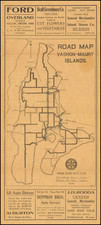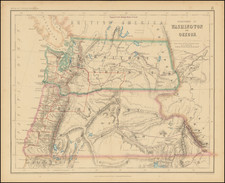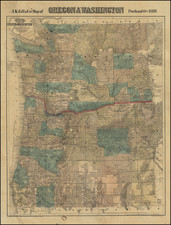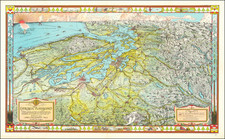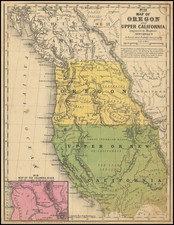Large promotional map of Hoquiam, near Gray's Harbor, Washington, published at the end of the Roaring 20s.
The map was published shortly after the first paper pulp mill was established in the area, during a period when the population of Hoquiam rose from 2,608 in 1900 to about 16,000 at the start of the Great Depression. Notably, between the time of the publication of this map and the census of 1930, roughly 25% of the population had already left Hoquiam.
The map includes a fine image of the subdivisions, public transit lines, railroads and of course the bustling waterfront, where lumber, shingle, pulp and other businesses are shown. At the far southwest along the waterfront, several proposed waterways are shown, Number 1, Number 3 and Number 4, in anticipation of future growth which would soon fade away with the Crash of 1929 and the Great Depression.
On the verso is a map of Gray's Harbor County and a series of photos of the area.
Hoquiam
Hoquiam's history begins with the logging industry in Washington and later with the production of paper pulp.
The earliest operation in the area was established by Ed Campbell in 1872. About 10 years later, Captain Asa M. Simpson, a Pacific Coast mariner and businessman in the lumber industry from San Francisco, provided the financing for the Northwestern Mill. In 1881, Simpson sent his manager, George Emerson, to Hoquiam to establish a mill there, and Emerson purchased 300 acres for the new mill and lumber operation. By September 1882, the Simpson mill was producing its first lumber products.
In 1886, Captain Simpson merged his mill with the Miller Brothers mill, also located in Hoquiam, and named it the Northwest Lumber Company The mill was later renamed the Simpson Lumber Company, and retained that name until 1906.
The extension of the railroad from Aberdeen to Hoquiam, beginning in 1898, contributed to the continued importance of logging and lumber in Hoquiam. In 1927, a pulp mill was established under the name of Grays Harbor Pulp Company. A year later, a Pennsylvania company- the Hammermill Paper Company- became interested in Grays Harbor Pulp Company. When the Pennsylvania company bought stock in the Grays Harbor Pulp Company, the Grays Harbor pulp Company built a paper mill and became the Grays Harbor Pulp & Paper Company.












